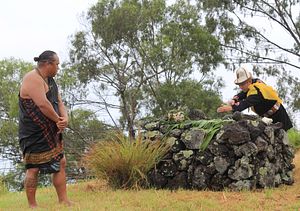The clash between industrialized societies and indigenous peoples is nothing new — exploitation of resources for economic gain goes back centuries. What is new is a growing recognition by conservation bodies that native people and their sacred lands demand greater protection and respect.
In an effort to build support for their sacred lands, a delegation of around two dozen (mostly) indigenous people from ten countries participated in the International Union for Conservation of Nature (IUCN)’s World Conservation Congress in Hawaii in September. They traveled from Asia, Africa, and the Americas to raise awareness of the threats they face and to call for greater safeguards against extractive industries and infrastructure development.
A central theme of the Hawaii-hosted WCC, which drew over 10,300 participants from 192 countries, was the vital role indigenous people play in protecting biodiversity, ecosystems, and in preserving native knowledge. At the conclusion of the ten-day congress the IUCN announced the creation of a new category of membership supporting indigenous rights. It also passed a motion calling for governments and landowners to “give high priority to avoiding environmentally damaging industrial activities and infrastructure development that impact sacred natural sites and territories and areas conserved by indigenous peoples…”
While the motion is not legally binding, Liz Hosken, director of the U.K.-based Gaia Foundation, said it was a tool for applying pressure on governments to protect sacred lands.
“There are certain areas that are critical from an ecological or cultural heritage perspective or from the perspective that people who want to live according to different values — like indigenous people — have the right to do so,” she said.
Victoria Tauli-Corpuz, UN special rapporteur on the rights of indigenous peoples, said awareness of indigenous rights among conservation bodies has changed significantly in recent years. “Before there was hardly anything but now, because there are more and more indigenous peoples coming, [conservation groups] are really talking about the challenges that they face.”
She added that the profile of indigenous people still needs to be higher because, depending on how conservation is approached and to what degree they’re included, establishing protected areas can be helpful or harmful for indigenous peoples.
When an area receives a protected designation it can actually lead to the entry of mining corporations, agribusiness expansion, or infrastructure development, Tauli-Corpuz warned. “In the end the whole goal of conservation gets defeated because you are also using it as a ploy to allow for the entry for these kinds of investments.”
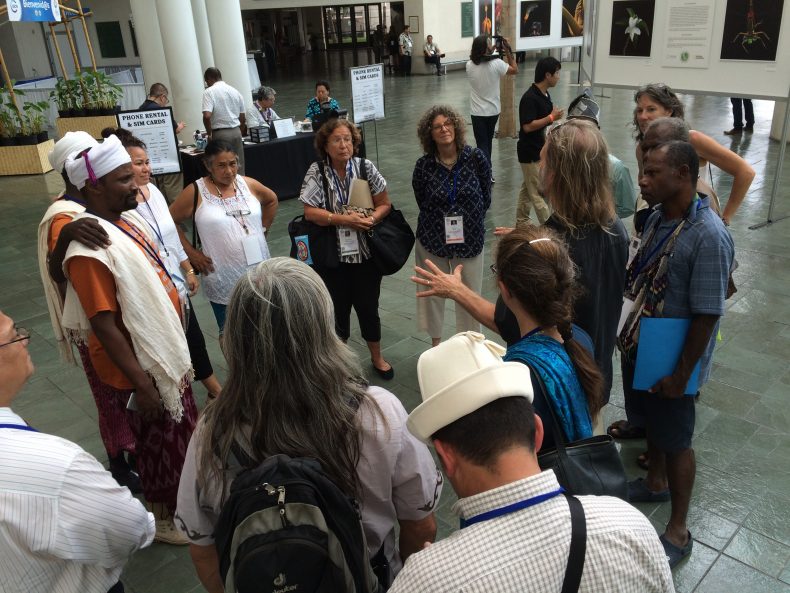
Filmmaker Christopher McLeod of the Sacred Land Film Project speaks to a delegation of indigenous people at the World Conservation Congress in Hawaii. Photo by Jon Letman.
The Battle for Borneo
On September 3, the same day Native American protesters and their allies were attacked with pepper spray and dogs in North Dakota over the disputed Dakota Access Pipeline being built on Standing Rock Sioux tribal lands, the international sacred lands WCC delegation, organized by filmmaker Christopher McLeod, gathered in Hawaii to call for protection of their own sacred places under threat from extractive industries like oil and gas pipelines, logging, mining, oil palm plantations, road infrastructure, and mega-dams.
Two of the delegates were from Malaysia’s Sarawak state on Borneo. Peter Kallang, chairman of SAVE Rivers Sarawak, an ethnic Kenyah, lives along Sarawak’s Baram River, which is also home to his fellow delegate Komeok, an ethnic Penan. While both men are from the same district, their differing ethnicities and languages reflect Sarawak’s biological and human diversity.
Kallang spoke of rapid deforestation in Sarawak dating back to the 1980s. “They’ve been cutting left, right, and center,” he said, describing both legal and illegal logging. “We’ve lost at least 95 percent of the primary or virgin forest in the last 30 years.”
In the rush to build oil palm plantations, forests are cut, pesticides, herbicides, and fertilizers used, and rivers, essential to indigenous peoples, are heavily polluted and silted. Meanwhile, internal power holders — government officials and their families — have been accused of and documented engaging in allegedly illegal transactions that result in personal enrichment at the expense of Sarawak’s environment and its indigenous people, according to the environmental watchdog group Global Witness.
“Everything is at stake for the indigenous people of Sarawak. The government is selling off their land without their consent,” said Jettie Word, executive director of the non-profit Borneo Project. She says the forests are being logged at an alarming rate, turned into oil palm plantations, and the government is supporting a series of mega-dams that threaten to destroy thousands of hectares of forest while displacing tens of thousands of people whose cultural identity is “inextricably linked to their land.” She’s referring to projects like the 2,400 MW Bakun Dam, Asia’s largest dam outside of China.
As Malaysia’s government strives to become a developed nation by 2020 (2030 for Sarawak), the proposed Sarawak Corridor of Renewable Energy is driving the push for cheap electricity and with it smelting plants, aluminum, iron, metals, and hydroelectric and coal power plants.
“For us, the indigenous in Malaysia, the river is related to us, the land is related to us,” Kallang said. “We should be able to have a voice in how the land [and rivers] are being used, controlled, and preserved. At the moment the government doesn’t recognize us as far as these things are concerned.”
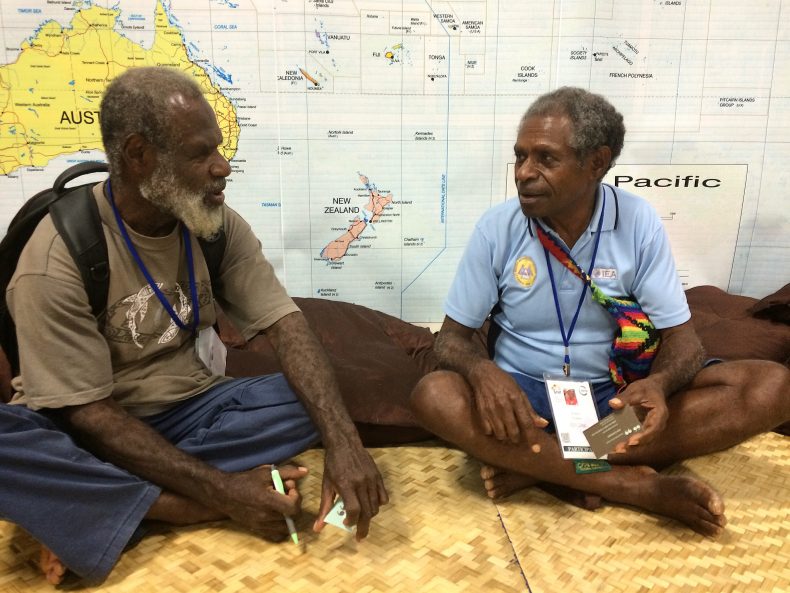
Two indigenous leaders from Papua New Guinea, Ware Melchior (left) and Porer Nombo, discuss the impacts of extractive industries on their sacred lands and water at the IUCN World Conservation Congress. Photo by Jon Letman.
Mining Wealth, Stripping Culture
Some 4,000 kilometers east of Borneo is Papua New Guinea (PNG)’s Madang Province, home to speakers of 200 distinct languages. Three men, each representing a different ethno-linguistic group from Madang, attended the WCC with a unified message: the region’s sacred land, water, and rich biodiversity cannot be separated from its people and their culture.
Porer Nombo is a traditional medicine man, philosopher, and village leader of the Nekgini-speaking people along Madang’s Rai Coast. Nombo, who has co-authored an ethnobotanical study of medicinal and culturally important plants, says that many of PNG’s youth are attracted by new technology and extractive industries like mining but he worries that comes at the expense of preserving knowledge of traditional medicine and culture.
Speaking in Tok Pisin (PNG’s pidgin) and translated to English by fellow delegate Ware Melchior, Nombo said, “The land is connected and we are connected… and we belong to the land. The land provides for us, it does not belong to us. We belong to the land.”
Melchior, a Mbermba-speaker of the Songnor people along Madang’s Ramu River, explained how his people hold a very different worldview from Western cultures, in which he says people are judged as either being a “pass” or a “fail.”
“In our society — Melanesian society — nobody’s a failure because we all live off the land,” Melchior said. He explained that for the indigenous people of PNG, sacred lands and rivers are facing immediate and continuous threats from copper, gold, cobalt, and nickel mining and from oil and gas projects.
Melchior called the rate of change he’s seen in his lifetime “amazing in terms of the deforestation and mining practices” and said while such projects always build high hopes for economic benefits, in reality the result is widespread environmental degradation. Extractive industry not only threatens sacred lands, he says, it is harmful to local subsistence farmers. “We end up losing a lot of land and resources, even rivers.”
A third delegate from Madang Province was Takia-speaking indigenous biologist Banak Gamui. A lecturer at the University of Goroka, Gamui said participation in the WCC played an important role in fostering understanding between indigenous and non-indigenous cultures.
“In my view, for the world to understand us, we have to also understand them at their level but also be able to connect with our own cultures,” Gamui explained, referring to the 800 unique cultures found in Papua New Guinea, a country a little larger than California.
“What I think has happened in so many parts of the world is happening much faster in Papua New Guinea,” Gamui said, referring to the loss of cultural traditions and environmental degradation.
“The human race needs to wake up… and realize that we’re all in this together,” Gamui noted. “We’re fighting the same cause so if we can understand each other across different superficial boundaries, I would say then we will get it right.”
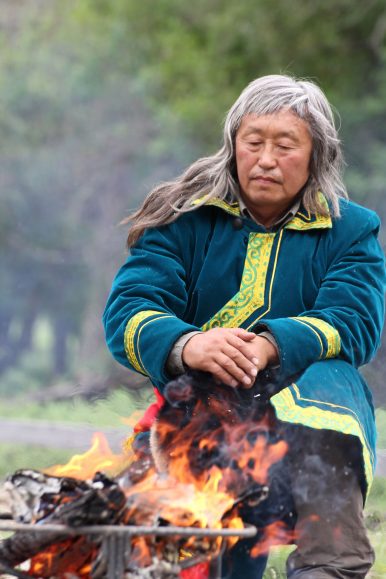
Danil Mamyev is an indigenous community leader and spiritual practitioner in southern Siberia’s Altai Republic.
Photo by Christopher McLeod.
Breaking the Heart of Asia
Half a continent from Borneo and Papua New Guinea, in the heart of Central Asia, nomads, shepherds, and shaman inhabit the steppes and mountains of Kyrgyzstan and southern Siberia’s Altai Republic. The remote land-locked region, considered sacred by its first people, is also being targeted for gas and oil pipelines, logging, road construction, tourism (including hunting/poaching) hydroelectric power, and a limited amount of mineral deposits.
One of the delegates representing Central Asia’s indigenous people was Kamil Mamadaliev. Known as a manaschi (a reciter of Kyrgyz Manas epic poetry), Mamadaliev preserves and imparts his people’s culture through the trance-like recitation of the half a million line-long ancient poem.
Broadly speaking of “a world out of balance,” he says his people’s sacred lands, including the Alatoo Mountains, which are home to snow leopards and other wildlife, are under threat. “Thinking about the animals and wildlife and plants and landscapes that have protected and nurtured us,” Mamadaliev says, “now it’s our job to take care and protect them.”
Translating for Mamadaliev was Jennifer Castner, director of The Altai Project, a nonprofit that works to protect the natural and cultural heritage of the Altai region. Castner said Altai is unique in that it is home to a UNESCO World Heritage site, multiple federally and regionally protected areas and a climate change refuge for endangered snow leopards. The region, which straddles the frontiers of Russia, Mongolia, China, and Kazakhstan, is also home to other big cats, ungulates, endangered birds, and rare plants.
Castner warned of growing unchecked tourism and plans for a Chinese transportation corridor that would connect northwest China with southern Siberia: “Opening this glacier-covered closed mountain border would inflict irreparable damage on the indigenous people’s traditional lifeways, sacred landscapes, and critical wildlife populations and habitat.”
She also pointed to a possible threat from an international gas pipeline that has been proposed to run between China and Russia. Like many large resource extraction and development projects, Castner says the pipeline’s route is “poorly studied, local residents are ill-informed, and the project is largely economically infeasible [and designed] to increase the power and wealth of governments, large corporations, and their contractors.”
Castner was accompanied by two indigenous men from the Altai Republic: Vyacheslav Cheltuev and Danil Mamyev.
Cheltuev comes from a shaman clan in Siberia’s Kosh-Agach district. Since childhood he has lived closely with the plants, animals, and nature of his homeland on the Chuya steppe. His grandparents were nomads and migrated between Mongolia, China, and Russia’s Tuva Republic before there were national boundaries. Recalling his grandfather’s repression and exile under Stalin, Cheltuev says today’s threats come from an unpredictable and changing climate that has brought drought, extreme heat, and unusually heavy snowfalls to his land.
Beside Cheltuev sat indigenous community leader Danil Mamyev who described his work as “protecting sacred knowledge in the Karakol Valley.” He’s concerned about how his culture and land are being impacted by government officials who completely disregard traditional values and indigenous knowledge. By attending the world’s largest conservation gathering in Hawaii and raising the profile of his home, he hopes more people will recognize that cultural and natural landscapes cannot be separated.
“Governments around the world, and internationally at the UN level and IUCN, by making separate policies governing culture and landscape, they are essentially tearing indigenous people away from their traditional landscapes,” Mamyev said. “We are unable to have that relationship with land that is an intrinsic part of our culture.”
By traveling to Hawaii and learning from other indigenous people from Africa, the Americas, and across Asia, Mamyev said he gained a sense of connectedness. “By uniting, we would be much better able to convey our message and work together, especially since we are separated by arbitrary political boundaries.”
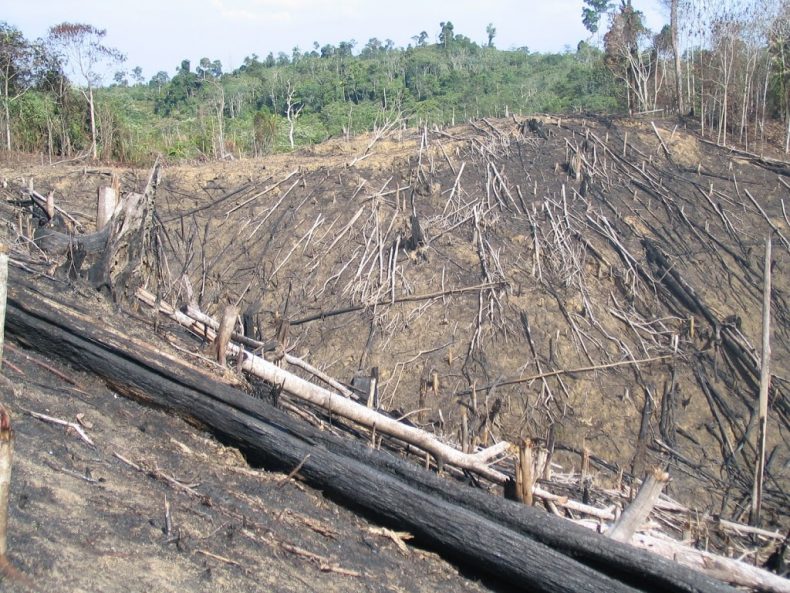
A forest in Borneo, devastated either for logging or to make room for a palm oil plantation. Photo by Jessica Lawrence, the previous director of the Borneo Project,
Win Together or Lose Together
Although IUCN director general Inger Andersen called indigenous people “key stewards of the world’s biodiversity,” they still often struggle to be heard and understood. The UN’s Tauli-Corpuz says environmental safeguards and long-term protection of the planet demands the respect of indigenous peoples. “Many of the remaining protected areas which are better kept in terms of biodiversity are indigenous territories. That should be an incentive for states as well as conservation organizations.”
“Unfortunately, that’s not what’s happening. The incentive is when they get money and they don’t look at conservation as economically profitable,” said Tauli-Corpuz, adding: “ If we don’t do anything significant to stop these kinds of destructive activities that are going to really mean the destruction of the planet, then we all lose together.”
Jon Letman is a Hawaii-based independent journalist covering politics, people, and the environment in the Asia-Pacific region. He has written for Al Jazeera, Foreign Policy in Focus, Inter Press Service and others.













